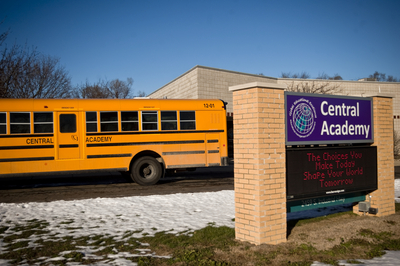Analysis: See which Michigan schools add most value for students
- Read more about local schools: Report: Ann Arbor Public Schools, Central Academy beat test-score expectations
A new Bridge Magazine analysis released Thursday ranks Michigan schools based on schools' test scores adjusted for family income, showing where students are not only achieving but overachieving.

Central Academy was named Bridge Magazine's top value-added schools in the state.
Joseph Tobianski | AnnArbor.com
Bridge and Public Sector Consultants created a Value-Added Matrix (VAM) to determine its 2012 Academic State Champs, celebrating schools that are finding a way to push learning through the socioeconomic ceiling.
School districts traditionally thought of as high-performing do well in the analysis, but the top 10 is dominated by charter schools and high-poverty districts not typically recognized for academic success.
Bridge says the methodology may seem counterintuitive to some, but it also shows the complexity of comparing success and failure in vastly different school districts.
Locally, Ann Arbor Public Schools and charter school Central Academy both made the rankings. AAPS is among the top-10 value-added affluent and traditional school districts in the state, while Central Academy is the fifth most value-added school in all categories.


Comments
ThinkingOne
Fri, Jan 11, 2013 : 5:48 p.m.
Some key factors with this that are not discussed at all are: The name appears to be misleading. It does not really seem to measure any value-added items. Rather it measures actual results against predicted results. This is more like a 'Beating Expectations' ranking. Depending on how poorly you are expected to do, you can get an excellent Value Added ranking without actually adding much in 'Value'. The rankings are based strictly on income level; and that is measured just on one variable: whether or not a student is eligible for a free or reduced lunch - not even that one variable is broken down into the two categories its name suggests. And although the article mentions several instances of school / districts that have a high percentage of ESL students, that factor is not counted. Going forward, you have the prospect that, as the lower performing schools / districts begin to succeed, they may raise the expected level of performance and may begin looking like they are no longer succeeding; or at least as if they aren't doing the job they used to. This would also make the schools that are performing at an even lower level look like they are getting even worse than they are. Since there is not a working link to the methodology explanation, we can't judge how the 'expected' level of performance is determined. Having said all that, it is good to see that there is work being done on measuring effective teaching that is based on something other than raw test scores.
Rick Stevens
Thu, Jan 10, 2013 : 8:06 p.m.
'The scoring system is similar to one introduced by the Mackinac Center for Public Policy in June.' The minute I see 'Mackinac Center I think 'privitize everything and things will be wonderful'. I would be very surprised to see 'Bridge magazine' say anything positive about anything that wasn't private so this fluff isn't much of a surprise. The private academies can cherry pick their students much like private health insurers do with their insured (vs Medicaid or Medicare) and, surprise, surprise end up getting better scores and higher profits. When is aa.com going to actually do some investigative reporting and not just re-print fluff? Cheerleading for the Mackinac Center and SPARK isn't news or even journalism in my opinion.
dotdash
Thu, Jan 10, 2013 : 6:59 p.m.
It is almost impossible to evaluate whether this methodology makes any sense at all, since Bridge's link to the methodology page doesn't work.
Macabre Sunset
Thu, Jan 10, 2013 : 6:20 p.m.
Good. We need a matrix that assesses the gappiness quotient as it relates to the achievement gap and the parenting gap. Top-peforming schools could earn mall credits that students can use at The Gap.
GoNavy
Thu, Jan 10, 2013 : 6:09 p.m.
I think that the "value-added matrix" (VAM) used here is interesting, but such measurements are good only for administrators - while doing little for students. It's hard to explain to a student that "you're still an underachiever, but your school is great because given how we expected you to perform (i.e. "poorly"), you did OK." That student remains an underperformer - and frankly, your school's "VAM" makes no difference on a resume.